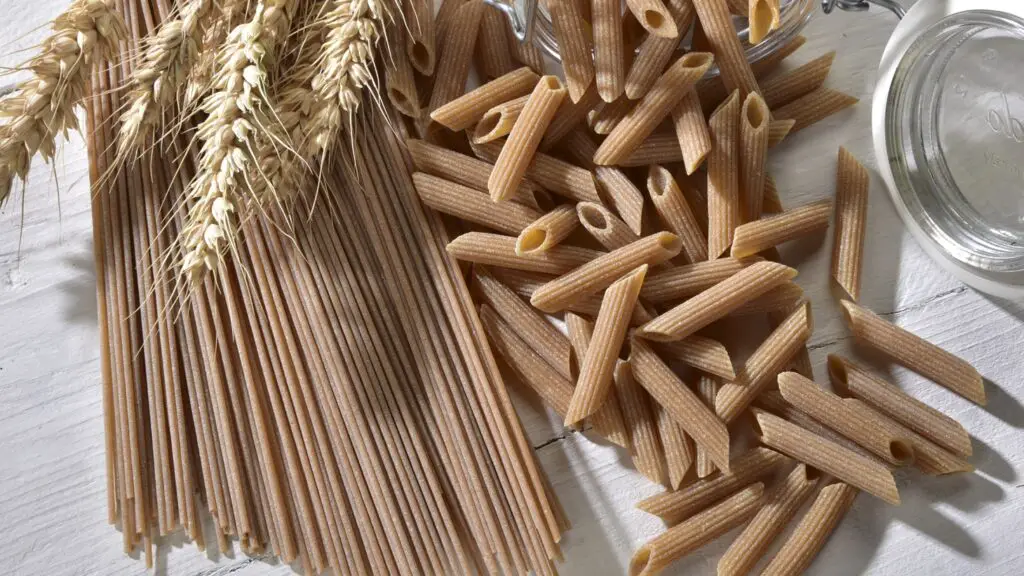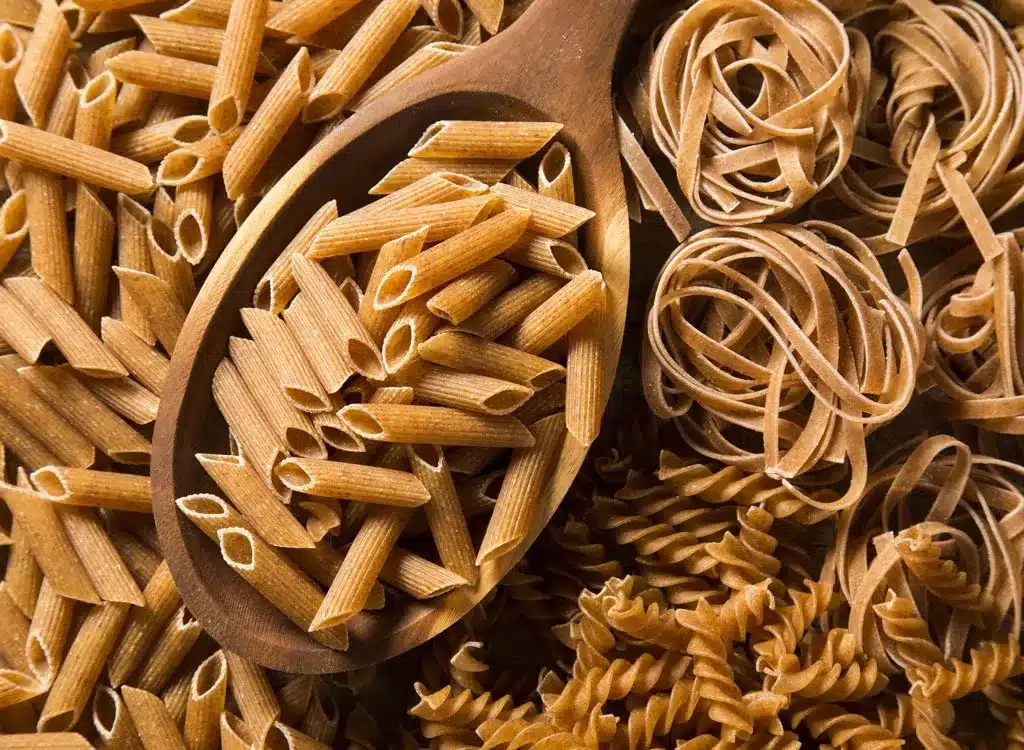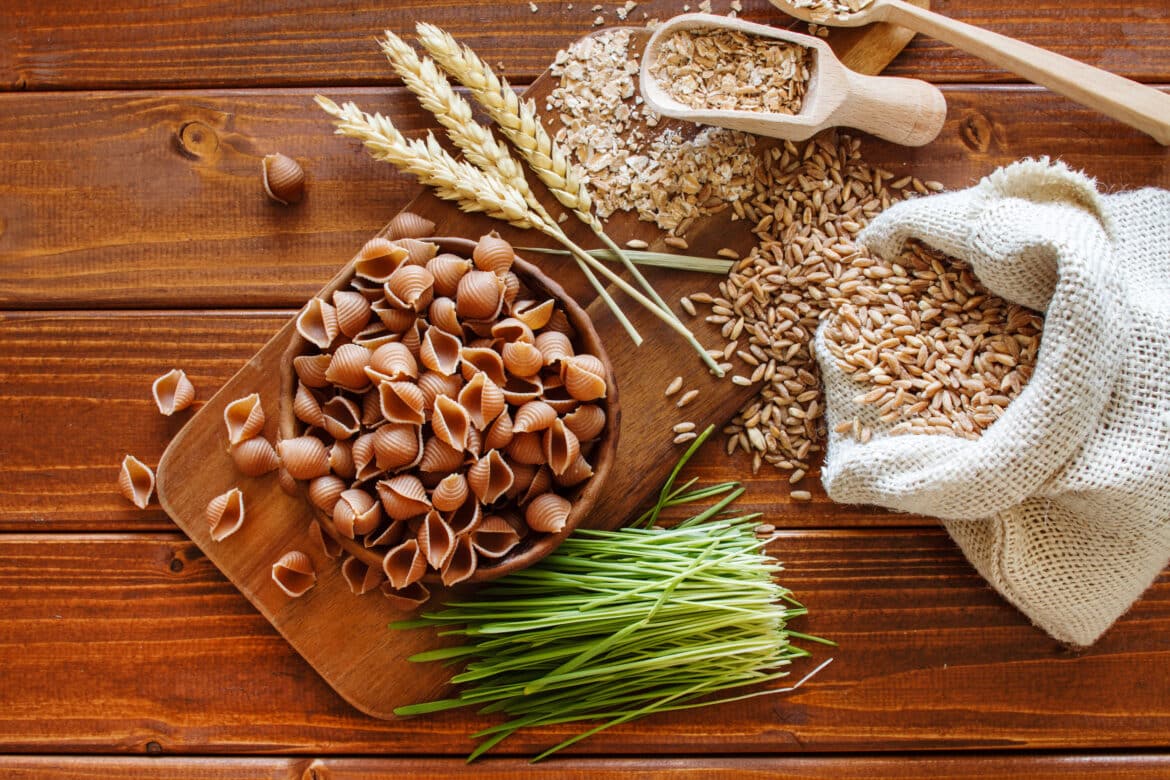Introduction
Is Whole Wheat Pasta Healthy For Weight Loss: Whole wheat pasta is a variation of the beloved pasta dish, with one critical distinction: it’s crafted from whole wheat flour, which contains all parts of the wheat grain, including the nutrient-rich bran and germ. In contrast, traditional pasta is typically made from refined wheat flour, which has been stripped of many of its beneficial components. This difference in ingredient composition sets the stage for a nutritional showdown.
One of the most significant advantages of whole wheat pasta for weight loss lies in its higher fiber content. Fiber plays a pivotal role in satiety, the feeling of fullness and satisfaction after a meal. Whole wheat pasta’s increased fiber content can help curb overeating and snacking between meals, making it easier to adhere to a reduced-calorie diet. The fiber in whole wheat pasta contributes to a slower digestion process, which stabilizes blood sugar levels and helps prevent energy crashes that often trigger unhealthy food cravings.
Whole wheat pasta boasts a more favorable nutritional profile compared to its refined counterpart. It contains a higher concentration of vitamins, minerals, and antioxidants, such as B vitamins, iron, and magnesium, which are essential for overall health and metabolism. This makes whole wheat pasta a nutrient-dense choice, providing the body with the essential elements it needs to function optimally during a weight loss journey.

Which pasta is best for weight loss?
In fact, whole wheat or whole grain pasta is the best option for weight loss as whole wheat pasta takes longer to digest than pasta made from refined flour. Slower digestion means blood sugar will rise slowly after consumption, preventing your body from storing excess fat.
Whole Wheat Pasta: Whole wheat pasta is an excellent choice for weight loss. It’s made from whole wheat flour, which contains more fiber and nutrients than traditional white pasta. The fiber content helps you feel fuller for longer, reducing the likelihood of overeating. Additionally, whole wheat pasta has a lower glycemic index, which can help stabilize blood sugar levels.
Gluten-Free Pasta: Gluten-free pasta options, such as those made from brown rice, quinoa, or chickpea flour, are suitable alternatives for individuals with gluten sensitivities. These options can also be lower in calories and carbohydrates compared to traditional pasta. However, be mindful of portion sizes, as gluten-free pasta can still contribute to calorie intake.
Bean-Based Pasta: Pasta made from beans, like lentils or black beans, is a protein-rich alternative. Protein is essential for weight loss because it helps control appetite and maintain lean muscle mass. Bean-based pasta is often gluten-free and provides a satiating effect.
Spaghetti Squash and Zoodles: For those looking to cut carbohydrates and calories further, spaghetti squash and zucchini noodles (zoodles) are excellent options. These vegetable-based alternatives are low in calories and carbs while providing a satisfying pasta-like texture.
Can I eat pasta if I’m trying to lose weight?
A single serving of pasta will do very little harm to your fat loss goals. So if you keep your portion sizes under control, you should be just fine. One serving equals 1 cup of cooked pasta. Pro Tip: When eating pasta, make it your side dish to complement a bigger portion of protein and veggies.
Mind Your Portions: Regardless of the type of pasta you choose, portion control is paramount when trying to shed pounds. Be mindful of the serving size, which is usually around 2 ounces (about 1/2 cup of cooked pasta). Avoid the common habit of piling your plate with pasta, which can lead to excess calorie intake.
Balance with Protein and Veggies: To create a balanced and weight-friendly pasta dish, incorporate lean sources of protein and plenty of vegetables. Grilled chicken, shrimp, tofu, or lean ground turkey are excellent choices. Vegetables not only add volume and nutrients but also help control calorie intake.
Savor the Sauce: Pay attention to the type of sauce you use. Opt for tomato-based sauces with herbs and vegetables, as they tend to be lower in calories compared to cream-based or cheese-heavy sauces. Homemade sauces allow you to control the ingredients and limit added sugars and unhealthy fats.
Consider Gluten-Free Alternatives: If you have a gluten sensitivity or are looking to reduce your gluten intake, consider gluten-free pasta options like brown rice pasta, quinoa pasta, or chickpea pasta. These alternatives can be lower in calories and offer different nutrient profiles.
Is whole wheat pasta good for belly fat?
However, incorporating whole-grain pasta in a balanced diet with regular exercise may aid in overall weight loss, which can reduce belly fat.
Fiber Content: Whole wheat pasta is made from whole wheat flour, which retains the bran and germ of the wheat grain. This means it contains more fiber than traditional white pasta. Fiber plays a significant role in weight management and belly fat reduction because it helps you feel full and satisfied, reducing overall calorie intake.
Lower Glycemic Index: Whole wheat pasta typically has a lower glycemic index (GI) compared to its refined counterpart. Foods with a lower GI release sugar into the bloodstream more slowly, helping to stabilize blood sugar levels and reduce cravings for high-calorie snacks.
Nutrient Density: Whole wheat pasta is richer in essential nutrients like vitamins, minerals, and antioxidants compared to white pasta. These nutrients can support overall health and may contribute to better weight management.
Satiety: Due to its fiber and nutrient content, whole wheat pasta can enhance satiety, helping you stay satisfied for longer periods. This can potentially lead to reduced overall calorie consumption and, consequently, a decrease in belly fat over time.
Is it OK to eat whole wheat pasta everyday?
It is possible to eat pasta daily and still be healthy. The key to eating pasta every day is to limit your portion size and supplement your pasta bowl with essential nutrients. The portion size is two ounces of dry pasta or one cup of cooked pasta.
Rich in Fiber: Whole wheat pasta contains more dietary fiber than white pasta. Fiber is essential for digestive health and can help regulate bowel movements, lower cholesterol levels, and stabilize blood sugar.
Nutrient Dense: Whole wheat pasta is more nutrient-dense, containing vitamins, minerals, and antioxidants that are stripped away during the refining process of white pasta production. It provides essential nutrients like B vitamins, iron, magnesium, and selenium.
Lower Glycemic Index: Whole wheat pasta typically has a lower glycemic index compared to its refined counterpart. This means it causes a slower and more gradual increase in blood sugar levels, promoting better energy control and reduced cravings.
Satiety: Due to its higher fiber content, whole wheat pasta can help you feel fuller for longer periods, potentially reducing overall calorie consumption and aiding in weight management.
Can we eat Suji pasta during weight loss?
Summary. Suji, or semolina, is an excellent addition to a weight loss diet due to its high protein content, which aids in building and repairing muscle tissue. Protein can also lower appetite, preserve muscle mass during weight loss, and increase fat loss.
Moderate Calorie Content: Suji pasta is relatively moderate in calories, making it suitable for those aiming to manage their calorie intake. A standard serving of suji pasta (about 2 ounces or 1/2 cup cooked) typically contains around 200 calories, which can fit into a balanced weight loss plan.
Satiety Factor: Suji pasta, like most pasta varieties, provides a sense of satiety due to its carbohydrate content. This can help curb hunger and prevent overeating, which is crucial for weight loss.
Protein Content: Semolina flour, the primary ingredient in suji pasta, contains more protein than regular wheat flour. Protein is essential for preserving muscle mass and promoting a feeling of fullness.
Low in Fat: Suji pasta is naturally low in fat, which can be beneficial for those who are conscious of their fat intake during weight loss.
Versatility: Suji pasta can be used in a variety of dishes, from traditional Italian recipes to fusion cuisine. Its versatility allows you to experiment with different ingredients and flavors to create satisfying, low-calorie meals.
How can I eat pasta on a diet?
Eating simple pasta without any veggies would mean loading up on carbs. Instead, add lots of sautéed veggies to your pasta, such as corn, broccoli, zucchini, bell peppers, onions, olives and jalapeños. This will also reduce your overall consumption of carbs-loaded pasta and increase your fiber intake.
Choose the Right Type of Pasta
Opt for Whole Wheat Pasta: Whole wheat pasta is a healthier option compared to traditional white pasta. It contains more fiber, which promotes satiety and helps stabilize blood sugar levels.
Explore Alternative Pasta Options: Consider trying pasta made from legume flours (e.g., chickpea or lentil pasta) or vegetable-based noodles like zucchini or spaghetti squash. These alternatives tend to be lower in carbohydrates and calories.
Control Your Portions
Measure Your Pasta: Stick to serving sizes, which typically range from 2 to 3 ounces (about 1/2 to 3/4 cup of cooked pasta). Using a kitchen scale or measuring cup can help you accurately portion your pasta.
Fill Your Plate with Veggies: To make your pasta dish more filling without adding extra calories, load up on vegetables. Create a pasta-vegetable ratio that leans towards more veggies.
Pair with Lean Proteins
Incorporate Lean Proteins: Include lean sources of protein like grilled chicken, turkey, shrimp, tofu, or beans in your pasta dishes. Protein helps you feel full and satisfied, reducing the urge to overeat.
Mindful Sauce Selection
Choose Tomato-Based Sauces: Tomato-based sauces tend to be lower in calories and healthier than cream-based alternatives. They’re also rich in antioxidants and vitamins.
Make Your Own Sauce: Preparing homemade pasta sauces allows you to control the ingredients, reducing added sugars, unhealthy fats, and excessive sodium.
Why am I losing weight eating pasta?
Pasta typically has a low-GI, meaning that it increases your blood sugar levels at a slower rate than other refined carbohydrates, such as white bread. The researchers from St Michael’s Hospital in Toronto found that those who ate pasta as part of a low-GI diet actually ended up losing a small amount of weight.
Caloric Density:
Pasta itself is not incredibly calorie-dense when portioned correctly. It’s often the sauces and toppings that significantly contribute to calorie content. Choosing lighter, tomato-based sauces with fewer calories and pairing pasta with vegetables and lean proteins can help keep the overall meal’s calorie count in check.
Calorie Deficit:Weight loss occurs when you consume fewer calories than you expend. If you are losing weight while eating pasta, it may be because you’ve created a calorie deficit through exercise and a balanced diet.
Active Lifestyle:Physical activity plays a crucial role in weight loss. If you’re incorporating pasta into your diet while maintaining an active lifestyle, you may be burning off the calories consumed from pasta and other foods more effectively.
Stable Blood Sugar Levels:Whole wheat pasta, in particular, has a lower glycemic index compared to white pasta. Foods with a lower glycemic index help stabilize blood sugar levels, reducing cravings for high-calorie snacks and promoting weight loss.
Metabolism and Individual Variation:Metabolism varies from person to person, and some individuals may metabolize carbohydrates more efficiently. If you are losing weight while eating pasta, it could be due to your unique metabolism and how your body processes carbohydrates.
How much pasta a day for weight loss?
Well, consider that one food guide serving – one-half cup – of cooked pasta (no sauce) has 104 calories. I am not suggesting you eat only half a cup of noodles, that’s not much. For a meal, I typically advise my weight loss clients to keep their portion of cooked pasta to 1 to 1.5 cups (women) and 1.5 to 2 cups (men).
Balanced Diet:Weight loss isn’t just about the amount of pasta you eat but also about the overall balance of your diet. Pasta should be part of a balanced meal that includes lean proteins, vegetables, and other nutrient-dense foods.
Whole Wheat Pasta vs. Regular Pasta:If you choose whole wheat pasta over regular pasta, you may be able to enjoy slightly larger portions due to its higher fiber content. The fiber can help increase satiety and control hunger.
Frequency:While there is no strict limit on how often you can eat pasta for weight loss, it’s essential to maintain variety in your diet. Don’t rely solely on pasta for your carbohydrate intake; include other sources like whole grains, fruits, and vegetables.
Monitoring and Adaptation:Regularly monitor your progress and adjust your portion sizes as needed. If you find that you are not losing weight as expected, consider reducing your pasta portion or increasing your physical activity level.

Conclusion
Whole wheat pasta’s standout feature is its elevated fiber content, derived from the inclusion of the nutrient-rich bran and germ of the wheat grain. This increased fiber content promotes a sense of fullness and helps control appetite, making it easier for individuals to adhere to calorie-controlled diets. Moreover, the slower digestion of fiber-rich foods contributes to stable blood sugar levels, reducing the likelihood of energy crashes and unhealthy food cravings.
Additionally, whole wheat pasta boasts a superior nutritional profile compared to its refined counterpart, delivering essential vitamins, minerals, and antioxidants. These nutrients are pivotal for overall health and metabolic efficiency, further supporting the body’s weight loss efforts. Exercise caution and moderation when incorporating whole wheat pasta into one’s diet. While it offers numerous benefits, overconsumption can still contribute to excessive calorie intake. Portion control remains paramount in any weight loss plan, even when opting for healthier food choices.
Whole wheat pasta is a commendable to a weight-conscious diet. Its fiber content, nutrient density, and slower digestion can facilitate weight loss efforts by promoting satiety and stable energy levels. However, it should be consumed as part of a well-balanced eating plan that includes a variety of nutrient-rich foods, along with regular physical activity. Ultimately, the journey to achieving and maintaining a healthy weight is a holistic endeavor, and whole wheat pasta can be a valuable tool in this pursuit when used wisely and in conjunction with other health-promoting practices.

